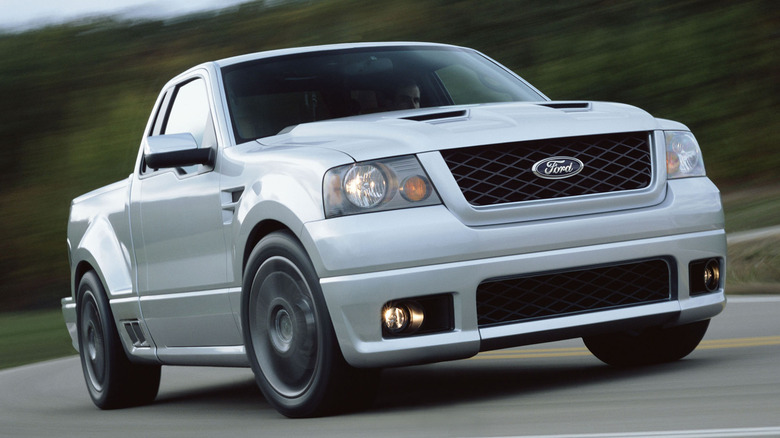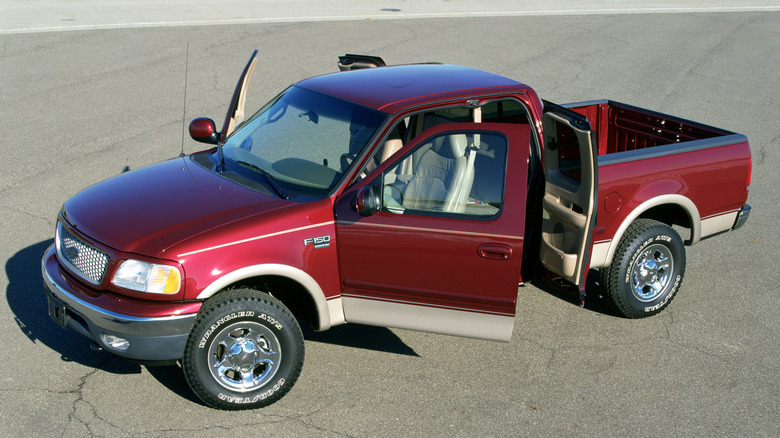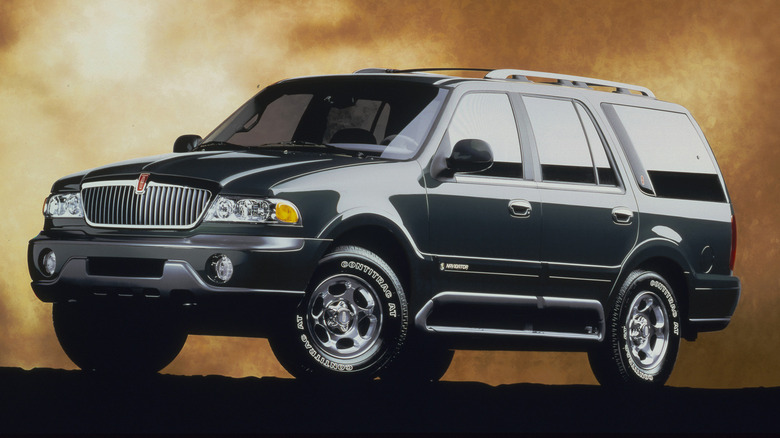This Is The Worst Engine Ford Ever Put In A Truck
Ford's F-150 pickup truck was the top-selling vehicle in the United States last year, which shouldn't be a surprise since it's held that title for over 40 years. According to Ford, a new F-150 is sold every 49 seconds and a big chunk of that allure is the F-150's reputation for reliability. Unfortunately, the brand jeopardized that image somewhat with its de facto V8 engine spanning from 1997 to 2010 in the F-150 and slightly longer in other models.
Though perhaps not as sinister as some enthusiasts portray, Ford's 5.4 liter V8 does indeed raise a couple of legitimately scary concerns, while other shortcomings are simpler and more affordable to remedy or prevent. For a little background info, the 5.4, nicknamed "Triton," was available in multiple configurations with 2, 3, and 4 valves per cylinder, making anywhere from 235 to 550 horsepower and 330 to 510 foot-pounds of torque depending on the application.
Those applications include the aforementioned F-150 truck and Expedition SUV (and their luxurious Lincoln counterparts), as well as the Mustang Cobra, and even a few rarities such as the Ford GT supercar. While not the worst engine ever made, you should know the risks involved and whether your comfort level might be better served by skipping it altogether.
The spark plugs can blow out of the cylinder heads
In what's surely the genesis of the 5.4 V8's questionable reputation, early 2-valve examples had a serious design flaw in the cylinder heads atop each bank of cylinders. Simply put, the aluminum material that the spark plugs thread into isn't thick enough to get a sufficient number of turns on the spark plug to securely hold it in place against the cylinder pressure that's generated during the combustion process. There have been many instances of spark plugs stripping their threads and actually blowing out the side of the cylinder heads, an event that the unlucky driver likely won't soon forget.
One solution is to sleeve the existing spark plug hole and cut new, deeper threads into the cylinder head, but this is obviously a pricey endeavor — requiring the cylinder heads to be removed from the vehicle — and best left to a professional mechanic. Some knowledgeable Ford technicians also suggest that frequently checking that the spark plug torque is set to factory specifications (which means using a torque wrench if doing this yourself) will go a long way toward preventing spark plug blow-out.
It's also worth considering avoiding vehicles with this engine variant altogether since the 3-valve replacement that was phased in beginning in approximately 2003 corrected the spark plug issue and had more horsepower to boot.
Early fuel pumps often failed
Not as catastrophic as self-ejecting spark plugs, some 5.4 liter V8s are known to have issues with their fuel delivery system, which is a cornerstone of the internal combustion process. The weak link in the fuel system on some older models is the fuel pump driver module, an aluminum component that's mounted toward the rear of the F-150's steel frame. The intrusion of water, dirt, salt, and other foreign objects can cause the module to suddenly fail, immediately starving the engine of fuel and stalling it.
Fortunately, Ford later revised the fuel pump driver module design to make it more weatherproof and less prone to failure. The revised part cost less than $100 and it's well within the realm of a handy do-it-yourselfer to replace. If you want to check whether your truck has been updated, the old-style module mounts directly to the steel frame, whereas the newer part has spacers that distance it from making direct contact.
The timing chain can be problematic
Unlike the more simplistic American V8 pushrod engines dating back to the 1950s, the 5.4 Triton has what's known as overhead cams — camshafts mounted in the cylinder heads rather than a single cam nestled inside the engine block. One compromise of the overhead cam design is that a longer timing belt or in Ford's case, a timing chain, is needed to snake around and rotate the cams off the crankshaft and the longer a timing chain is, the more potential that exists for stretching over time.
The Triton's timing chain also has a series of tensioners and guides to keep it properly aligned and taut, but some critics mention that the factory materials are inferior and subject to accelerated wear. Because the 5.4 is an "interference" engine, the pistons and valves can make contact and cause extreme damage if the engine's timing drifts too far out of whack because of chain stretch or improper tension, so be aware of unusual noises and/or rough running.
Replacing the timing chain itself or its accessory components is neither cheap nor easy. The procedure requires disassembling the entire front of the engine and is best left to a professional mechanic, but it is less expensive than replacing an entire engine that blew itself up.
Frequent oil changed are mandatory
While we're talking about the valvetrain, the 3-valve 5.4 liter V8 also has a poor reputation for oiling those critical components, leading to premature wear. The cylinder heads are prone to accumulating sludge and other debris, some say because the oil passages are too small to begin with. The Variable Valve Timing (VVT) feature that optimizes power or fuel economy based on conditions is also controlled by oil pressure and can become compromised by sludge.
Therefore, mechanics recommend performing oil changes much more frequently than Ford's service manual recommends. The old adage of doing oil changes every 3,000 miles — which has largely been extended to at least double that duration in the age of more stable synthetic oils — probably still applies to the Triton V8 to be on the safe side.
In summary, some mechanics like YouTuber "Car Wizard" (in te video above) recommend against buying any vehicle with a 5.4-liter engine but to be fair, mechanics are only seeing a small handful of the literally millions of these engines that have been produced over the years, the majority of which didn't fail. Still, what is considered an acceptable failure rate, and why subject your company to all of the bad publicity, even if it does come from a small yet vocal minority? If you're considering a used truck with the 5.4 liter Triton V8, especially the 3-valve per cylinder version, it's probably best to assume the worst and set some funds aside for repair or replacement.


